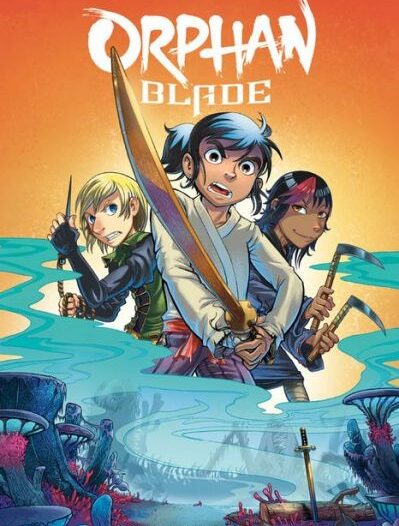
Review: Orphan Blade
 Orphan Blade
Orphan Blade
Written by M. Nicholas Almand
Drawn by Jake Myler
Oni Press; $19.99
This is a somewhat difficult book to discuss, as a fact regarding its creation, once known, hovers over it and colors one’s reading of it (if you don’t know it going in, however, you won’t find out until the first of the eight pages of the back-matter). It also reads like it was quite clearly intended to be the very first volume in a series of graphic novels, perhaps a rather large number of graphic novels, as the book is in many ways reminiscent of the opening tankobon of an epic-length series, although there won’t—and can’t be—future volumes, going back to that same fact regarding its creation.
It is therefore a somewhat imperfect book, and one that will likely frustrate readers when they hit that “The End” in the last panel, when they will be expecting a “To Be Continued” instead. But does that render the endeavor of reading it any less than worthwhile?
ADVERTISEMENT
ADVERTISEMENT
Not exactly.
It’s still a fairly fun adventure book, one that is quite clearly and quite heavily influenced by manga and anime, with an elaborate back-story full of big, imagination-firing ideas that suggests almost endless areas available for future exploration.
During an event-stuffed, five-page prologue, we learn that long ago a group of mystics and alchemists tried to open a portal through which they could see God and instead loosed the giant, terrifying monsters the Japanese called kaiju onto the world. The apprentice of one of these men eventually discovered a way to combat the monsters by forging powerful, magical weapons from the bones and body of the one kaiju human beings managed to kill—although it took them thousands of soldiers to do so.
The story is set after these world re-shaping events, when large areas of the Earth have been given over to a supernatural blight caused by the kaiju, and the weapons forged to fight and kill the kaiju have become almost as big a problem as the kaiju themselves were, as now the humans who possess those weapons have taken to turning them on one another.
Our hero is Hadashi, a mischievous kleptomaniac of a young martial arts student. After he loses three fingers to a blight-infected frog, he falls in with two friends and begins working with Dr. Africa, the man who originally forged the mystical weapons. Before long, he crosses paths with a gang called The Five Fingers of Death, each of whom holds a kaiju weapon, and who have been hired to kill Hadashi once he himself stumbles upon a weapon of his own (it’s called “The Orphan Blade,” and it possesses whoever holds it, essentially wielding its wielder in combat).
ADVERTISEMENT
ADVERTISEMENT
Myler’s fully-colored artwork isn’t as strongly manga-influenced as Almand’s script seems to be, although similarities exist; in general, his characters have big heads and spindlier bodies, and though the story is set in mid-17th century Japan, these characters seem to come from all over the world.
Each piece of their fantastic weaponry bears its own name and its own powers and spectacular finishing moves, which are given their own names as well (“DEATHBLOW: SCARLET PINWHEEL” reads a panel in which Hadashi’s Orphan Blade cuts open a giant frog monster, from forehead to belly). Myler really gets to cut loose in the action scenes, several of which involve pretty bizarre monsters and acts of magical combat. His bright coloring applied to these sometimes elaborately detailed monsters calls to mind some of James Stokoe’s work on Orc Stain.
Suffice it to say that despite the various dangers presented by the blight monsters and the bounty hunters, our hero and his comrades survive until the end of the book and get a sort of happy ending, even if lots of sub-plots remain dangling and questions unanswered.
And, unfortunately, those sub-plots and questions will remain dangling and unanswered, as Almand died of cancer before this book saw print.
Despite writing comics for about a half-dozen years before his death, this was Almand’s biggest work up until then, and it has all the hallmarks of being a signature work for himself and collaborator Myler. It’s too bad that work had to end when it did, but, on the other hand, it’s nice that Almand got a work of this length published, offering readers something to remember him by, and a good reason to miss him.
Filed under: Reviews
About J. Caleb Mozzocco
J. Caleb Mozzocco is a way-too-busy freelance writer who has written about comics for online and print venues for a rather long time now. He currently contributes to Comic Book Resources' Robot 6 blog and ComicsAlliance, and maintains his own daily-ish blog at EveryDayIsLikeWednesday.blogspot.com. He lives in northeast Ohio, where he works as a circulation clerk at a public library by day.
ADVERTISEMENT
ADVERTISEMENT
SLJ Blog Network
The Moral Dilemma of THE MONSTER AT THE END OF THIS BOOK
Cover Reveal and Q&A: The One and Only Googoosh with Azadeh Westergaard
Fighting Public School Book Bans with the Civil Rights Act
ADVERTISEMENT







